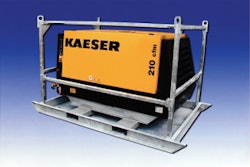Signed into law by President Bush on October 22nd, the American Jobs Creation Act of 2004 is a complicated piece of legislation. The objective of this new tax act is to stem the trend toward overseas production that is of growing concern to everyone. The government hopes to achieve this goal by creating incentives that stimulate domestic "production activities." Because these activities are broadly defined, US construction firms are positioned to reap substantial tax savings.
The new tax deduction is, in essence, a reward for US firms that have earned income from manufacturing and other production activities in the United States . And a significant reward it is! It is anticipated that the savings to taxpayers, as a result of this incentive, will approach $77 billion over the next decade. Those taxpayers who reinvest this savings stand to benefit significantly. Says John M. Kiely, Managing Member of Kiely Equipment Company LLC, "This incentive will allow us to continue to invest in new equipment for our construction equipment rental business, which makes our customers very happy."
Of primary importance to Utility & Transportation Contractors Association members, and all construction contractors, is the main provision included in Internal Revenue Code Section 199. Although the tax deduction in Section 199 is informally referred to as the “manufacturers' tax deduction,” it is more accurately called the “domestic production deduction.” Candidates for the tax deduction include contractors and subcontractors performing a wide range of construction activities, as well as those firms that deliver certain engineering and architectural services.
To understand the tax savings to construction contractors, this article will examine four key issues.
- Who qualifies for the domestic production deduction?
- How is this deduction calculated?
- What questions remain unanswered?
- What do I need to do to prepare to take the deduction?
Qualifying for the Domestic Production Deduction
Under the American Jobs Creation Act, firms that earn income from certain domestic production activities qualify for the deduction. For many firms, only a portion of their income, that percentage derived from "qualified production activities," is eligible to receive the deduction.
What production activities are ‘qualified'? Section 199 contains a somewhat detailed list of qualified activities. Qualified construction activities include: activities related to the erection or substantial renovation of real property, both residential and commercial buildings; the construction of the infrastructure to support these buildings, including roads, sidewalks, and power lines; permanent land improvements, including grading and landscaping; painting (possibly); and communication facilities and utility construction, including sewer/water systems.
To qualify, activities must be related to substantial construction and not be merely cosmetic. Tangential services such as hauling debris may not qualify. Of course, the deduction applies only to activities performed in the United States .
Are subcontractors eligible or does this only apply to the general contractor? Because more than one taxpayer may be engaged in construction activities, all contractors performing qualified activities may apply the deduction, even if the taxpayer does not have the benefits and burdens of ownership of the property being constructed. For example, a general contractor and a sub-contractor may both be engaged in the construction of a new building. Each taxpayer will calculate the deduction based on the percentage of profits derived from his or her activities related to this project.
Does the type of business entity matter? The tax deduction will be applied to “C” and “S” Corporations as well as Partnerships. The deduction is calculated at the partner or shareholder level, so that each partner or shareholder must compute his or her deductions independently. Each shareholder/partner is typically allocated a share of the income attributable to the qualifying activities of the “S” corporation/partnership along with other items necessary for the calculation, such as income, gain, loss and deduction. If necessary, there are a variety of reasonable methods available to the taxpayer to accurately determine the cost of goods sold related to the qualified production activities.
Calculating the Deduction
How much is the deduction? Beginning in 2005 and 2006, the provision allows for calculating a 3% tax deduction of: the lesser of either the net income derived from eligible activities (Qualified Production Activities Income or QPAI) or the overall taxable income for the year. This deduction will be treated as an additional tax deduction. In 2007 through 2009, the tax deduction grows to 6% and in 2010 and beyond, it will be fully implemented at 9%. It should be noted that the deduction is fully allowable for both Alternative Minimum Tax (AMT) and Adjusted Current Earnings (ACE) calculations.
What's the catch? Sound too good to be true? Well, sort of. There is a cap on the deduction. The deduction cannot exceed 50% of the wages paid to employees during the year. Despite this limitation, the new deduction can result in significantly reducing the taxable income for many businesses.
How are employee wages determined to set the cap? There are three alternative methods for computing W-2 wages, but the most common one is to permit a taxpayer to use the lesser of the wages reported in Box 1 or Box 5 on the W-2.
Can you give an example ? Consider Crowley Highway Construction Company (CHCC) which has taxable income in 2005 of $32 million. $24 million of this amount has been determined to come from qualified production activities. The company paid its employees wages totaling $5.8 million (W-2 Box 1), but Medicare wages (W-2 Box 5) totaled only $4.1 million.
The company's deduction would be calculated as follows. The firm has a QPAI of $24 million. Unhindered by the cap, its allowable deduction (QPAD) for 2005 would be ($24 million X 3%) or $720,000. However, we need to examine whether the cap applies. The wage limitation is ($4.1 million X 50%) or $2.05 million. Because the QPAD is less than $2.05 million, the cap does not apply and the deduction would equal $720,000. However, lets examine the situation in 2009 with no changes to revenues or wages. Now QPAD is ($24 million X 9%) or $2.16 million. Because QPAD is now higher than the wage limitation of $2.05 million, the allowable deduction is capped at $2.05 million.
Numerous Questions Remain
On June 29 th , George Manousos, a tax specialist in the Treasury's Office of Tax Legislative Counsel, spoke on the application of the deduction at a Washington D.C. luncheon. During his presentation, Mr. Manousos indicated that since the January 2005 release of Notice 2005-14, more than 70 comment letters have been received that pointed out issues needing clarification. During the latter half of this summer, proposed regulations are slated for release that will clarify the biggest concerns. Among the issues expected to be addressed are:
- Guidance on the allocation of indirect costs to qualified production activity income.
- The creation of a "simplified deduction method" to ease the burden of allocating and tracking costs for certain activities
- Specific rules as they apply to partnerships and pass-through entities
Further, State taxation bodies are just now weighing in on the subject. In a notice on July 8 th , New Jersey issued a statement indicating that New Jersey Corporate income taxes will be decoupled from IRC Sec. 199, meaning that the deduction will not apply for the purposes of calculating a firm's New Jersey State tax burden.
Preparing to Take the Deduction
So while there are still uncertainties remaining to be resolved, there are actions you can take today to ensure you maximize your deduction.
First, if you haven't already done so, discuss the deduction with your accountant. Given the impact to the bottom line, you want him or her up-to-speed. Do a mock-up of the wage limitation using 2005 estimates to determine if the wage limitation applies.
Second, either you or your accountant should begin a review of your job tracking/costing systems. The deduction necessitates being able to determine whether activities are "qualified," so having a means to track these costs is imperative. Although there is an added burden to calculate the new deduction, the overall benefits should mitigate the cost.
Finally, now is the time to have your accountant examine your cost structure with an eye towards maximizing the QPAI deduction. Every dollar saved is a dollar to your bottom line.

















